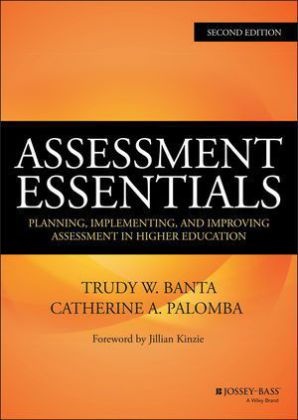Read more
A comprehensive expansion to the essential higher education assessment text
This second edition of Assessment Essentials updates the bestselling first edition, the go-to resource on outcomes assessment in higher education. In this thoroughly revised edition, you will find, in a familiar framework, nearly all new material, examples from more than 100 campuses, and indispensable descriptions of direct and indirect assessment methods that have helped to educate faculty, staff, and students about assessment.
Outcomes assessment is of increasing importance in higher education, especially as new technologies and policy proposals spotlight performance-based success measures. Leading authorities Trudy Banta and Catherine Palomba draw on research, standards, and best practices to address the timeless and timeliest issues in higher education accountability. New topics include:
* Using electronic portfolios in assessment
* Rubrics and course-embedded assessment
* Assessment in student affairs
* Assessing institutional effectiveness
As always, the step-by-step approach of Assessment Essentials will guide you through the process of developing an assessment program, from the research and planning phase to implementation and beyond, with more than 100 examples along the way. Assessment data are increasingly being used to guide everything from funding to hiring to curriculum decisions, and all faculty and staff will need to know how to use them effectively. Perfect for anyone new to the assessment process, as well as for the growing number of assessment professionals, this expanded edition of Assessment Essentials will be an essential resource on every college campus.
List of contents
List of Exhibits and Figures xiii
Foreword xv
Jillian Kinzie
Preface xix
About the Authors xxiii
1. Defining Assessment 1
Some Definitions 1
Pioneering in Assessment 3
Quality Assurance: An International Perspective 7
Assessment Purposes 9
Values and Guiding Principles 11
2. The Essentials of Assessment 15
Planning Effective Assessment 16
Engaging Stakeholders * Establishing Purpose * Designing a Thoughtful Approach to Assessment Planning * Creating a Written Plan * Timing Assessment
Implementing Effective Assessment 22
Providing Leadership * Selecting or Designing Data Collection Approaches * Providing Resources * Educating Faculty and Staff * Assessing Resources and Processes as Well as Outcomes * Sharing Findings
Improving and Sustaining Assessment 31
Obtaining Credible Evidence * Ensuring the Use of Assessment Findings * Reexamining the Assessment Process
Additional Thoughts 36
3. Engaging Faculty and Students in Assessment 39
Involving Faculty in Assessment 41
Faculty Responsibility * Assessment Resources for Faculty * Faculty Rewards * Maximizing the Role of Faculty and Faculty Acceptance * Some Stumbling Blocks in Understanding Assessment * The Nature of Resistance
Involving Students in Assessment 54
Student Responsibility * Resources for Students * Student Rewards * Maximizing Student Acceptance of Assessment
Acting with Integrity 63
4. Setting Expectations and Preparing to Select Measures 65
Intentions for Learning: Goals, Objectives, Outcomes 65
Defining Terms * Learning Taxonomies
Developing Statements of Expectations 69
Statement Content * Curriculum Maps * Using Matrices and Other Tools
Selecting Methods and Approaches 73
Inventories of Existing Activities * Developing Criteria for Choosing Methods * An Overview of Methods * Use of Existing Information * Locally Developed versus Commercial Measures * Comparing Potential Methods to Criteria
Designing Instruments 85
Recognizing the Uniqueness of Designing Instruments for Assessment * Enlisting Help from Campus Experts * Enhancing Instrument Reliability and Validity
Determining Approaches for Implementation 87
Research Strategies * Identifying Eligible Participants * Sampling and Sample Size
Putting Everything Together 91
5. Using Direct Measures 93
Using Classroom Assignments for Outcomes Assessment 93 Performance Assessment 95
Types of Performance Assessment * Using Performance Measures for Outcomes Assessment * Designing Effective Assignments
Rubrics 100
VALUE Rubrics * Some Rubric Issues
Aggregating Assessment Results in and across Courses 104
Using Objective Tests for Outcomes Assessment 105
Advantages and Disadvantages of Objective Tests * Developing Good Tests and Writing Good Items * Implications for Students
Electronic Portfolios 110
Using E-Portfolios for Outcomes Assessment * Choices for E-Portfolios * Student Reflection * Scoring * Resources and Training * Feedback * Impact on Students * Using Results * Developing E-Portfolios * Appeal of Portfolios and Some Cautions
6. Using Indirect Assessment Methods 121
Using Surveys in Assessment 121
Topics for Assessment Surveys * Selecting and Using Various Target Groups * Response Types and Scales * Writing Survey Questions * Questionnaire Administration * National Surveys for Assessment
Using Focus Groups in Assessment 132
Topics, Target Groups, and Participants * The Moderator's Ro
About the author
TRUDY W. BANTA is a professor of higher education and senior advisor to the chancellor for academic planning and evaluation at Indiana University-Purdue University Indianapolis. She is the founding editor of
Assessment Update, a bimonthly periodical published by Jossey-Bass.
CATHERINE A. PALOMBA is director emeritus of assessment and institutional research at Ball State University.
Summary
A comprehensive expansion to the essential higher education assessment text This second edition of Assessment Essentials updates the bestselling first edition, the go-to resource on outcomes assessment in higher education.

